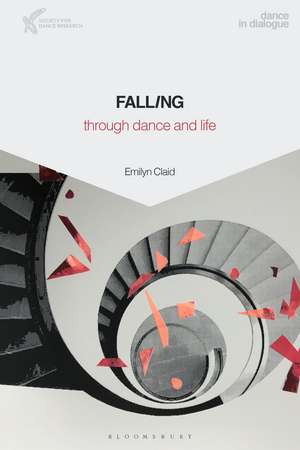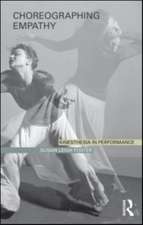Falling Through Dance and Life: Dance in Dialogue
Autor Dr Emilyn Claiden Limba Engleză Hardback – 13 ian 2021
| Toate formatele și edițiile | Preț | Express |
|---|---|---|
| Paperback (1) | 197.24 lei 6-8 săpt. | |
| Bloomsbury Publishing – 27 iul 2022 | 197.24 lei 6-8 săpt. | |
| Hardback (1) | 539.32 lei 6-8 săpt. | |
| Bloomsbury Publishing – 13 ian 2021 | 539.32 lei 6-8 săpt. |
Preț: 539.32 lei
Preț vechi: 773.42 lei
-30% Nou
Puncte Express: 809
Preț estimativ în valută:
103.20€ • 112.45$ • 86.96£
103.20€ • 112.45$ • 86.96£
Carte tipărită la comandă
Livrare economică 23 aprilie-07 mai
Preluare comenzi: 021 569.72.76
Specificații
ISBN-13: 9781350075719
ISBN-10: 135007571X
Pagini: 224
Ilustrații: 12 bw illus
Dimensiuni: 156 x 234 x 21 mm
Greutate: 0.49 kg
Editura: Bloomsbury Publishing
Colecția Bloomsbury Academic
Seria Dance in Dialogue
Locul publicării:London, United Kingdom
ISBN-10: 135007571X
Pagini: 224
Ilustrații: 12 bw illus
Dimensiuni: 156 x 234 x 21 mm
Greutate: 0.49 kg
Editura: Bloomsbury Publishing
Colecția Bloomsbury Academic
Seria Dance in Dialogue
Locul publicării:London, United Kingdom
Caracteristici
Makes transparent how practices of intentional falling can nurture alternative ways of living in the world that are relational, creative and life enhancing. Autobiographical, poetic, philosophical, analytical and theoretical voices layer each other to express an urgency to reconsider Western culture's fixation with uprightness and heights of success.
Notă biografică
Emilyn Claid's career stretches back to the 1960s when she was a ballet dancer with the National Ballet of Canada and the 1970s when she was co-founder of X6 Dance Space in London. In the 1980s she was artistic director of Extemporary Dance Theatre and in the 1990s worked as an independent dance artist. Emilyn has made choreographies for companies such as Phoenix Dance Company and CandoCo Dance Company, and has led choreographic research projects in Auckland, Hong Kong, Singapore, Berlin, Helsinki and Beirut. In 1997 she was awarded a PhD and published a book, Yes? No! Maybe. (2006). Since 2003 Emilyn worked as a professor at Dartington College of Arts and at University of Roehampton. In 2020 she resigned from the arena of academia to continue her free-lance career as dance artist, educator and psychotherapist.
Cuprins
1. IntroductionStructure and ContentFalling-through DanceA Practice of FallingConceptual FallsThe Contextual FabricBack Stories2. Falling Apart3. Falling Out4. Falling Away 5. Falling AboutReferences
Recenzii
This book is significant because it creates the space for more diverse considerations of falling-a space to reflect on previous experiences while opening readers' eyes to possibilities yet to catch their attention.
Falls in the time of concurrent disasters are metaphors, material and the means whereby we recalibrate what it means to be alive. Emilyn Claid's immensely readable writing offers readers a vertiginous ride and an encounter with limits. Inviting moving off the page, her call to incorporate the experiential, the reflective and the psycho-somatic through revitalising our attention to how to fall freely, badly, carefully and madly invigorates dance and performance scholarship through sensuous and dynamic critical engagement. Emilyn's compelling kinesthetic story is woven through her history of dance's relationships with gravity, making this an illuminating and deeply moving biography of the fall.
This writing pulls us into a multitude of rewarding and revealing falls. Slowly, carefully, and somatically as we sink into Emilyn's unravelling of dance's conflicting histories of resisting and relinquishing to gravity, and vertiginously as we tumble between decades of memories that elaborate the politics and pleasures of collapse.
Part historical account, part philosophical inquiry, part cultural critique, Falling through Dance and Life investigates falls both physical and metaphorical, intentional and accidental, humorous and tragic, to illustrate the significance of encounters with gravity along the lines of gender, race, sexuality, class, nationhood, and economics. Covering ground ranging from modern dance to circus to personal and national trauma, Claid provides an engaging account of the possibilities and enduring perils of falling.
This honest and thought-provoking book portrays Emilyn's lived experiences as a dancer, choreographer, academic and psychotherapist interweaving vivid descriptions of dance with moving personal experiences. The practical exercises which illumine her approach to falling are interspersed with themes including ageing and dying, diversity and inclusion and support and shame. We are encouraged to explore our embodied relationships and experiences of falling physically, psychologically and metaphorically as a resource for building resilience, living with uncertainty and as a source of vitality and presence.
Falls in the time of concurrent disasters are metaphors, material and the means whereby we recalibrate what it means to be alive. Emilyn Claid's immensely readable writing offers readers a vertiginous ride and an encounter with limits. Inviting moving off the page, her call to incorporate the experiential, the reflective and the psycho-somatic through revitalising our attention to how to fall freely, badly, carefully and madly invigorates dance and performance scholarship through sensuous and dynamic critical engagement. Emilyn's compelling kinesthetic story is woven through her history of dance's relationships with gravity, making this an illuminating and deeply moving biography of the fall.
This writing pulls us into a multitude of rewarding and revealing falls. Slowly, carefully, and somatically as we sink into Emilyn's unravelling of dance's conflicting histories of resisting and relinquishing to gravity, and vertiginously as we tumble between decades of memories that elaborate the politics and pleasures of collapse.
Part historical account, part philosophical inquiry, part cultural critique, Falling through Dance and Life investigates falls both physical and metaphorical, intentional and accidental, humorous and tragic, to illustrate the significance of encounters with gravity along the lines of gender, race, sexuality, class, nationhood, and economics. Covering ground ranging from modern dance to circus to personal and national trauma, Claid provides an engaging account of the possibilities and enduring perils of falling.
This honest and thought-provoking book portrays Emilyn's lived experiences as a dancer, choreographer, academic and psychotherapist interweaving vivid descriptions of dance with moving personal experiences. The practical exercises which illumine her approach to falling are interspersed with themes including ageing and dying, diversity and inclusion and support and shame. We are encouraged to explore our embodied relationships and experiences of falling physically, psychologically and metaphorically as a resource for building resilience, living with uncertainty and as a source of vitality and presence.































